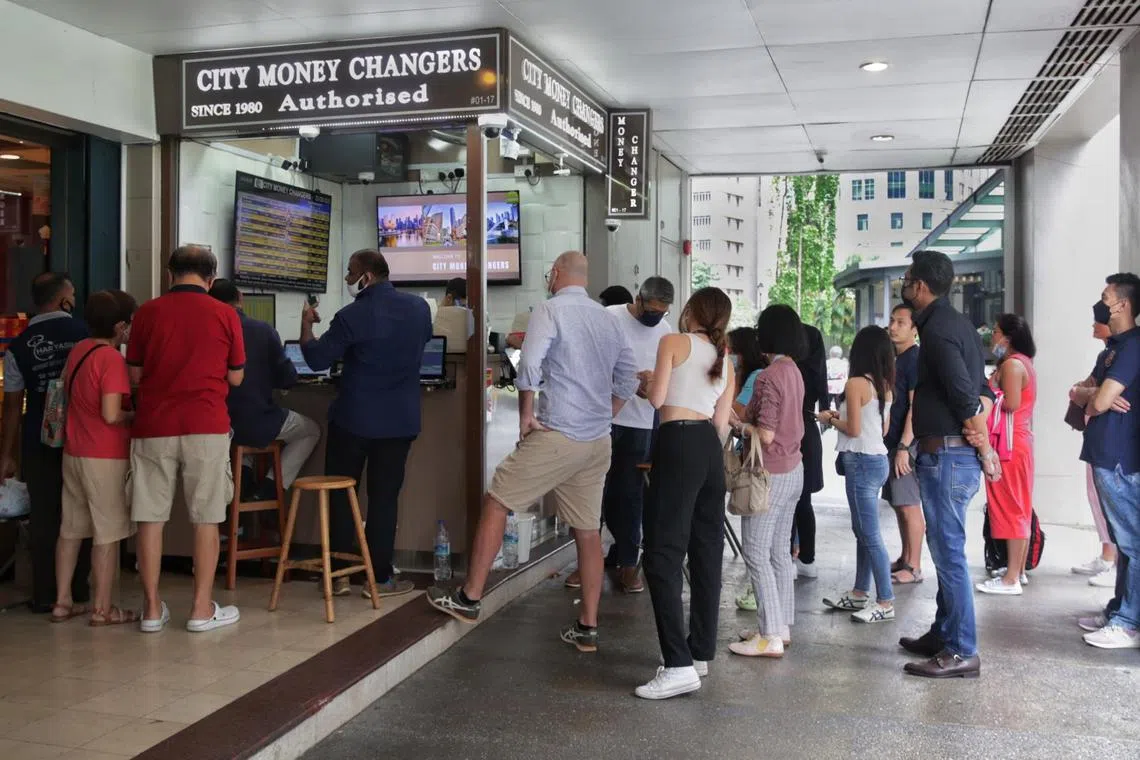Expect Sing$ strength to taper against major foreign currencies by mid-2024, analysts say
Sign up now: Get ST's newsletters delivered to your inbox

Even after a 2 per cent decline since the end of December, the Singapore dollar has stayed near the top of the pack in Asia.
ST PHOTO: GIN TAY
Follow topic:
Singapore – The Singapore dollar has trounced currencies like the ringgit, yen and Australian dollar while holding up well against a stronger euro and US dollar in 2023, enabling Singaporeans with extra cash to better afford school fees, holidays and shopping sprees overseas.
But those with plans to travel should expect to soon enjoy less for every Singapore dollar converted into foreign exchange and spent abroad, as the local currency could start to lose its resilience against major currencies by next year, analysts said.
Since October 2021, the Monetary Authority of Singapore (MAS) has allowed the Singapore dollar to appreciate
This is done to cool inflation by guiding the Singapore dollar nominal effective exchange rate (S$Neer) higher within the band, allowing Singaporeans and domestic businesses to benefit from the increased buying power arising from a stronger local currency. Overall inflation in Singapore is now around 4 per cent.
Still, Singapore has lost steam with exports falling for an 11th straight month
With global demand declining, the local economy is forecast to grow at a much slower pace in 2023 compared with the year before.
Thus, analysts now reckon the S$Neer is trading at the upper range of the policy band. While the consensus is for MAS to keep its policy on hold to further keep inflation in check at its next meeting on Friday, more see a limited runway for the local currency to continue appreciating.
“We no longer see the S$Neer outperforming other currencies moving forward,” said Mr Michael Wan, senior currency strategist at MUFG Bank.
“The next big move for the Singapore dollar will come if and when MAS signals a more dovish policy stance, which will lead to a weakening of the currency.”
MUFG sees US$1 being equivalent to $1.32 in the next 12 months, strengthening considerably from $1.365 on Monday.
Meanwhile, investors have turned to the US dollar amid rising US Treasury yields an escalating conflict
The Singapore dollar should also start to weaken against the euro next year as the euro zone recovers, he added.
The region has struggled as a result of cost pressures arising from a spike in oil prices
“But markets have now priced in higher commodity prices from a protracted conflict between Russia and Ukraine. Corporate risk-taking and investments should return, given that the euro zone is supported by its population size and well-diversified sector mix from agriculture and technology,” Mr Saktiandi said.
Against that backdrop, Maybank sees strength returning to the euro and the Singapore dollar weakening against the currency from the middle of next year. On Monday, one euro traded for $1.44.
While the Singapore dollar should retain its strength against the Malaysian ringgit for the rest of the year, things are also expected to change in 2024.
“The ringgit is very sensitive to changes in the Federal Reserve’s policy and has been weighed down by the high US dollar. Once the Fed starts to ease its rates, the ringgit should strengthen against the Singapore dollar,” said Mr Saktiandi.
He expects the Fed to guide for lower rates from the second quarter of next year, once the US economy starts easing and as other countries begin seeing their currencies strengthen from improving economies.
Mr Saktiandi said the ringgit also moves in tandem with the Chinese renminbi, adding that the ringgit could also gain strength once China’s central bank is able to stabilise the renminbi.
By the end of 2024, $1 is expected to be worth RM3.30 or less, according to Maybank. The exchange rate was $1 to RM3.46 on Monday.
While the Japanese yen has been among the weakest currencies against the Singapore dollar this year, this might not last for long.
Said MUFG’s Mr Wan: “The yen will continue to be weak for the rest of the year, given that inflation in Japan is now at an attractive level and sectors like tourism are benefiting. So, the Bank of Japan (BOJ) may not want to tighten its policy too soon.”
Still, a weak currency also implies that Japan could be importing inflation from its trade partners.
“As such, we see weakness in the yen continuing for the next three months but strengthening into 2024 as the BOJ tightens its policy and the rest of the world cuts rates,” he said.
On Monday, $1 was worth around 108.9 yen.

